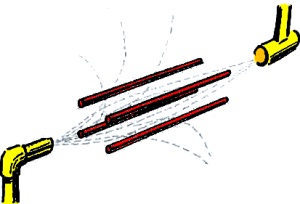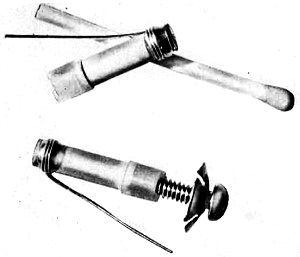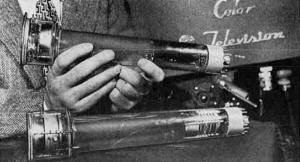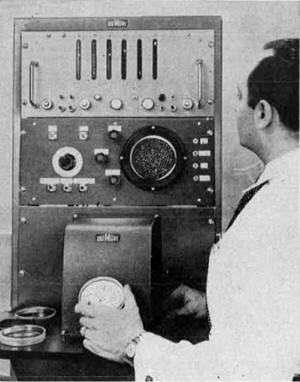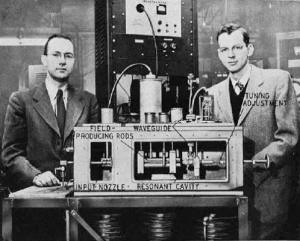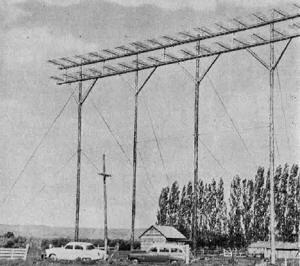Revolutionary New Oscillator-Amplifier |
|
When I read about Du Mont's Iconumerator, the first thing that came to mind was the video of the Rockwell Retro Encabulator and General Electric's Turboencabulator. As it turns out, the Du Mont device is real. This article from a 1955 issue of Radio Electronics discusses a new type of oscillator-amplifier that works on the principle of microwave amplification by stimulated emission of radiation (maser). It used ammonia as a masing medium. Masers were quickly applied to commercial broadcast systems, to military communications systems, and in laboratories. The state of the art has of course advanced far beyond the relatively crude apparatus shown here, but it is always good to have a working knowledge of the technology's history. Revolutionary New Oscillator-Amplifier By Fred Shunaman, Managing Editor Path of molecules through maser, showing separation of active and inactive ones.
Two of the new glass trimmer capacitors. New RCA tricolor Vidicon camera tube. Du Mont's Iconumerator, a device which can count objects of any size and shape in its field of vision. Here its subjects are similar to colonies of bacteria counted in medical laboratories, etc. The most startling feature of the in-strument is that the size of the object (as long as it can be contained in the field) or its shape make no difference in the accuracy of the numeration. The first experimental maser, with Professor Charles. H. Townes (left) and J. P. Gordon. Ellensburg, Washington, a town of about 9,000, is located 100 air miles and a range of mountains east of Seattle. Every attempt to receive a picture from Seattle met with failure. In a final attempt, the Jerrold-Northwest Community Co. hit upon a plan for the installation of 16 stacked Yagis. Half of the antennas are designed for channel 4, the other half for channel 5. The project was successful, and the people of Ellensburg are now receiving nearly perfect pictures. The antennas used are eight-element Baline Yagis, made by JFD. The instrument shown on our cover represents a completely new method of producing electronic oscillations or amplifying radio signals. Called "Microwave Amplification by Stimulated Emission of Radiation" (maser) it uses ammonia molecules as a source of energy and as an oscillating medium. The maser was developed at the Columbia Radiation Laboratory, which is jointly sponsored by the Armed Services and Columbia University. It was conceived by Prof. Charles H. Townes, executive officer of the Physics Department of the university. The work on it was carried out by him and his assistants: Dr. H. J. Zeiger, Carbide and Chemicals Co., post-doctoral fellow in physics at Columbia, and J. P. Gordon, a graduate student. The device was conceived as an aid to microwave spectroscopy, but its applications will cover a far wider field. Oscillations produced by the maser are so steady in frequency that they can be used in an "atomic clock" 20 to 50 times more accurate than any now in use or in a simplified navigation aid similar to Loran but dispensing with some of the stations necessary for that system. As an amplifier, it has a fantastic signal-noise ratio. The noise level is practically at the theoretical minimum level of zero. Thus, while the output of the amplifier is very low (about 10-9 watt), it can be used to amplify signals far below the noise threshold of the best vacuum tubes, bringing them up to a level where they can be amplified by more conventional methods. In spite of its large size, the maser is a microwave oscillator, operating at 23,870 mc, the resonant frequency of the ammonia molecule. The brass box is simply a container into which ammonia gas at low pressure (10-6 atmosphere) may be injected. It contains the active part of the equipment - four cylindrical electrodes which form an electrostatic field, and a resonant cavity about 1 centimeter in diameter and 3 inches long. It is also fitted with airtight seals through which pass waveguides, control adjustments and pipes for admitting and removing gas, pumping the chamber to a low pressure and circulating coolants. How It Works Operation of the maser is remarkably simple, though different from anything in the history of electronics. A stream of ammonia molecules is injected into the brass chamber and directed down the center of the field formed by the four copper cylinders. These molecules may be in one of two states - a low-energy state that may absorb energy and a high-energy one that can radiate energy. As they drift through the electrostatic field - formed by keeping two of the copper cylinders at a potential of 6 to 20 kilovolts and the two diagonally opposite grounded - the low-energy "dead" molecules are diverted and scattered while the high-energy ones are focused into a sort of beam which enters the resonant cavity just beyond the field. The process may be compared with the refining of uranium, in which the inert U-237 is removed and only the active U-235 left in a more or less pure state. Once inside the cavity, which is dimensioned to resonate at the frequency of the ammonia molecule, some of the molecules radiate - give up some of their energy. These tiny quanta of energy trigger other molecules, building up a chain reaction which may again be compared to that of purified uranium. In a short time the molecules have produced a vigorous oscillation in the cavity. The microwave energy is piped out of the cavity in an ordinary waveguide. This type of oscillation is unique - it is like nothing previously experienced in controlled electronic reactions. There is a local electric source - to maintain the high-voltage electrostatic field - but the energy which produces the oscillations does not come from that supply. It comes from the ammonia gas itself. Approximately 1014 molecules per second must be admitted into the chamber to maintain oscillation. The Maser as Amplifier If the number of ammonia molecules admitted is not great enough to sustain oscillation, the maser can act as an amplifier. An external signal may be introduced and increased in amplitude by energy picked up from the radiating molecules. The output of approximately one-billionth watt is high enough to apply to the grids of standard vacuum tubes, making the maser a preamplifier with a signal-to-noise ratio essentially equal to the limit set by fundamental thermal noise. The maser amplifier may in addition be cooled so that the fundamental thermal noise is further reduced. Coupling the signal to be amplified to the maser is simple. Signals have been transmitted down the waveguide which enters the resonant cavity at the top and the amplified signals reflected back through the same guide. Should it prove more convenient, the signals could be admitted from a guide on one side of the cavity, passed straight through and removed by a guide on the other side. The amount of amplification is linked with the stability of the device. Operated to give very high gain, the system may break into oscillation. An amplification factor of 100 can probably be obtained without serious instability. Two masers were in existence when this was written. It was necessary to build the second one so that it could check the first. No other instrument is accurate enough to test a maser. During the tests the oscillation frequencies were compared with an accuracy of one part in 100 billion. Professor Townes states that this is probably the most accurate comparison or measurement of any two physical quantities that has ever yet been made. While Professor Townes and his associates were chiefly interested in microwave spectroscopy, one of the most important immediate applications of the maser is as a frequency standard. It is at least 30 times as stable as the best systems using crystal oscillators. Thus it would make an excellent atomic clock. Incidentally, it operates on exactly the opposite principle from that of the atomic clock described in this magazine in the March, 1949, issue. In that clock, ammonia gas acted as a wave-trap at the resonant frequency, absorbing energy produced by a crystal oscillator. The maser produces its own power and does not have to depend on auxiliary equipment for its oscillations. It is expected to increase the resolution or detail which can be seen by microwave spectroscopy about 10 times, improving and extending our knowledge of the structure of molecules, atoms and nuclei. Many other applications - such as the navigation aid mentioned before - become apparent. The maser will find applications in radio astronomy and in many uses where a radio frequency must be measured with greater accuracy than is possible with present apparatus. But it is in directions unknown at present that the maser may find its greatest usefulness. Simply because it can act beyond our known horizons, it is difficult to assign its fields of future application. Who can say, for example, what uses there may not be for an amplifier which can amplify signals in a whole region which is now unexplored territory and whose very existence we may not suspect at present?
Posted October 5, 2021 |
|

